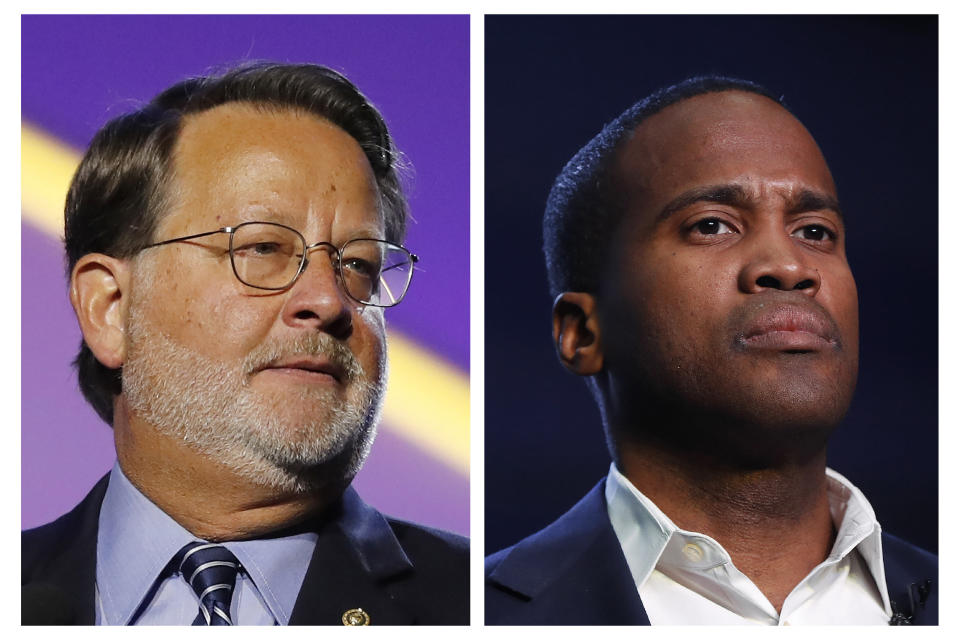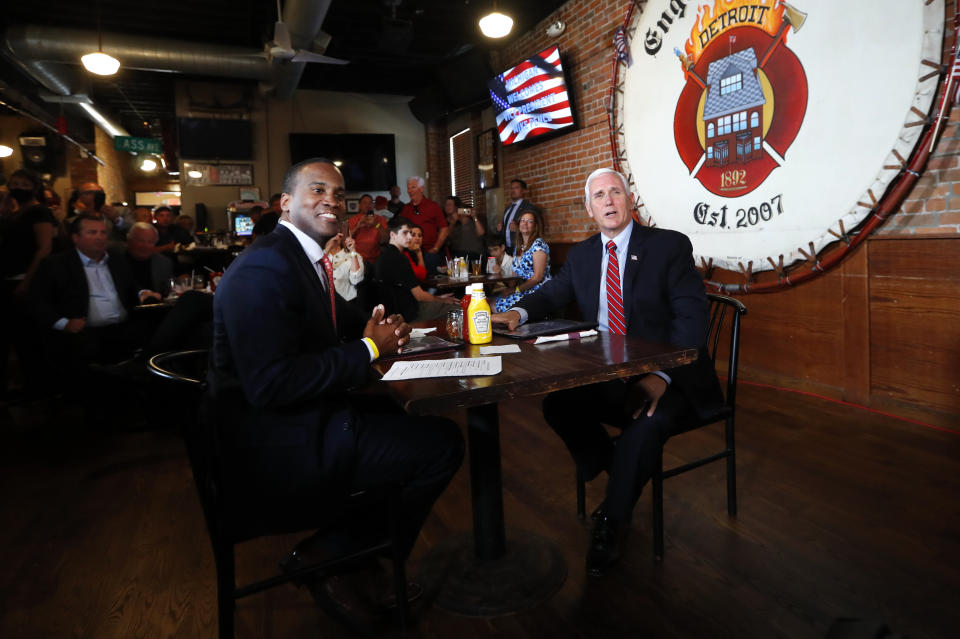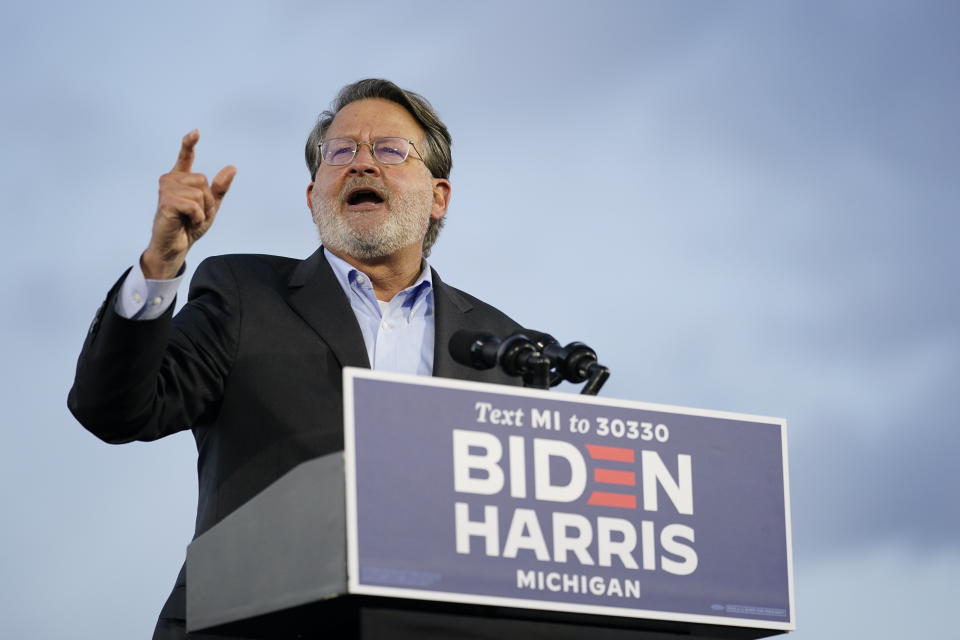GOP Pours Money Into Michigan, One Of Its Only Chances To Oust A Democratic Senator

Sen. Gary Peters (D-Mich.) can’t fully explain why there are so many undecided voters left in his state two weeks ahead of one of the highest stakes elections in a generation.
“That’s hard for me to answer,” Peters said in a quick phone call Sunday after a campaign stop in Waterford, Michigan, noting it’s not unusual for voters to tune in to an election late, let alone in a pandemic. “Michigan is a complicated place.”
According to a Detroit Free Press and EPIC-MRA poll in mid-October, Peters led by 6 percentage points over opponent John James, one of Republicans’ strongest recruits in the 2020 election cycle. But that survey had a larger-than-expected chunk of undecided voters: 11% of the total surveyed electorate and, notably, 18% of Black voters. This week, a Fox News poll found just 5% of likely voters were still undecided.
Poll after poll shows James, a young Black conservative entrepreneur and Iraq War veteran, within single digits of Peters, a first-term senator who is perhaps most known for being unknown. The matchup is one of the GOP’s few chances to oust an incumbent Democratic senator, and the result could hinge on that slice of undecided voters.
The numbers are keeping Peters’ campaign on its toes going into the final stretch of the election season. In 2016, Hillary Clinton fell short in Democratic strongholds like Detroit and Flint, particularly among Black voters — a dip in turnout that helped Donald Trump narrowly win the state by less than 11,000 votes.
State campaign finance watchers estimate the price tag of the race could be more than $100 million by Election Day.
This week, Barack Obama, whom Joe Biden’s presidential campaign is primarily deploying to Pennsylvania to encourage voter turnout among Black men, cut an ad for Peters, highlighting his work on passing the auto bailout, protecting health insurance coverage for those with preexisting conditions and securing more funding for Great Lakes restoration. Unlike most incumbents, who have the advantage of being known in their state, Peters started off his reelection campaign as a complete stranger to 36% of the state’s population.
But Peters has been attempting to raise his profile. He recently gained national attention for talking to Elle magazine about how he and his first wife decided to have an abortion in the 1980s. He became the first sitting senator to share his abortion story.
The demographics of undecided voters also suit Democrats. Jill Alper, a Democratic strategist in the state, summed them up as “single women, all ages, all races, we are talking about independents working two or three jobs.”
“People are not just sitting around and watching TV. They are frontliners,” she said.
In a year the GOP is defending upward of 10 competitive Senate seats, Peters’ seat in Michigan and Sen. Doug Jones’ in Alabama, are seen as Republicans’ only two opportunities to pick off Democrats this year since they’re in states Trump won in 2016 — and Republicans are going all in.
The Senate Leadership Fund, the super PAC aligned with Majority Leader Mitch McConnell (R-Ky.), raised $92 million in September and began October with more than $103 million in the bank, according to a Federal Election Commission report filed Tuesday afternoon. This week it announced an additional $5.6 million in ads against Peters, bringing its total investment to $14.6 million. Democrats have been keeping up the pace.
There’s been more spending on this Senate race than on the presidential race in the state. State campaign finance watchers estimate the price tag of the race could be more than $100 million by Election Day.
At a minimum, $19.2 million will be spent on Michigan’s U.S. Senate race this week alone, compared with $16.5 million slotted for the presidential race, according to an analysis by the Michigan Campaign Finance Network, a watchdog group.
But Democrats still have reason to be cautiously optimistic. James doesn’t only have to run against Peters, he also has to navigate Trump.
“In a true toss-up, Trump has to start doing better here,” Jessica Taylor, of the nonpartisan Cook Political Report, said of Michigan. “But in the broader scheme of things ... Republicans have sort of succeeded in keeping this competitive.”
For Democrats, the hope is a significant portion of Michiganders truly haven’t tuned into the fast-approaching Election Day, and once they do, they will vote against Trump’s pick for the seat.
John James Has A Trump Problem
The GOP saw potential in James after he lost to Sen. Debbie Stabenow (D-Mich.) in 2018 by 6 percentage points in his first political campaign. He came out of that race without a negative ad run against him and finished closer to Stabenow than most anticipated.
James has served two combat tours in Iraq. He calls his supporters part of his “army” and has made his whole campaign military-themed: He calls his platform “battle-tested”; his online hub for campaign volunteers is the “foxhole.”

He is running his race differently this year than he did two years ago. Mainly, there’s a lot less Trump. His appearance at the Republican National Convention was brief. He attended a rally with Trump in September, but skipped the president’s most recent visit to the state in October.
Trump has consistently polled behind Biden in Michigan; two weeks before Election Day, the Democratic ticket has an 8-point lead. Trump’s campaign has pulled back spending in Michigan since early September.
Peters, a moderate Democrat in the Senate, has always emphasized his record of bipartisanship. He authored six bills signed into law under Trump, including expanding training programs for small businesses and apprenticeships for veterans. His vision for Washington is to get back to a place where Democrats and Republicans can write big legislation together.
“Let me be clear, I’m a Democrat and I’m a proud Democrat and hold Democratic values,” Peters said in an interview with HuffPost. “But there’s a lot of governing that can be done in a way that we build some consensus and in the long run we have to return our country to that kind of way of operating.”
Now, James has taken to championing what he calls “nonpartisanship.” He refused to take a clear position on the recent Supreme Court vacancy, stating in a campaign email, “We need to get back to those times where people from both political parties worked together.”
It feels good on the ground in a 2012 way as opposed to a 2016 way in Michigan. Lavora Barnes, Michigan Democratic Party chair and Obama’s 2012 state director
In press interviews, he’s said he’ll push back against Trump when he needs to. James’ campaign and the official campaign arm for Senate Republicans did not respond to multiple HuffPost interview requests.
“When the president is right on what he’s doing for Michigan, I’ll support him,” James told The Detroit News in May. “And when I disagree with him, I will let him know. It benefits the state of Michigan to have that perspective and that voice.”
All that rhetoric, however, is backed by a standard conservative agenda, which Republicans in Washington have pushed forward in large part by standing with Trump. James wants to repeal and replace Obamacare, defund so-called sanctuary cities and cut environmental regulations. Democrats have done their best to remind voters that just two years ago, James said he supported Trump’s agenda “2,000%.”
It’s reportedly left voters who still haven’t fully tuned into the race confused about who is who. One Democratic voter told The New York Times that between James and Peters, his apolitical friends found it hard to tell who was the Democrat and who was the Republican.
The Political Climate Is In Democrats’ Favor
Peters unexpectedly won an election in 2014 — a year Democrats lost it all — and has spent his time in the Senate in the minority party. James failed to win in a Democratic wave two years ago. This year will be just as difficult.
“The quandary that Republicans across the board find themselves in — you can never really separate yourself from Trump even if that’s what might do best for you,” Taylor said. “He has the potential to pick off more African American voters than President Trump might be on course to pick up there, but the math still seems pretty hard for them unless the national climate and the climate in Michigan changes for Republicans.”
Love HuffPost? Become a founding member of HuffPost Plus today.

Peters has had an overwhelming advantage with Black voters in Michigan so far. In mid-October, he was leading James 61% to 8% among African Americans, who make up nearly 40% of the electorate in Michigan’s most populous county.
Nearly 1.8 million mail-in ballots out of the 3 million requested have been returned in Michigan as of this week. Biden remains dominant in the state, emphasizing get-out-the-vote efforts targeted at Michigan’s Black communities.
And Michigan is one of six states that still has “straight-ticket voting” — meaning voters can choose an entire party’s slate of candidates with a single mark on the ballot. Democrats are cautiously confident; the demographics of the undecided voters swing in their favor, and fewer and fewer voters are interested in splitting their ballots these days.
Lavora Barnes, chair of the Michigan Democratic Party and Obama’s state director in 2012, says she isn’t expecting a repeat of what happened four years ago.
“It feels good on the ground in a 2012 way as opposed to a 2016 way in Michigan,” she said.
Correction: This article previously stated Peters has authored four bills signed under Trump. He has actually sponsored six. We regret the error.
We want to know what you’re hearing on the ground from the candidates. If you get any interesting ― or suspicious! ― campaign mailers, robocalls or hear anything else you think we should know about, email us at scoops@huffpost.com.
This article originally appeared on HuffPost and has been updated.

 Yahoo Finance
Yahoo Finance 
